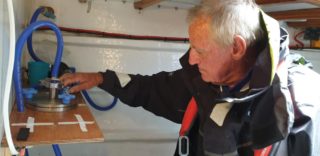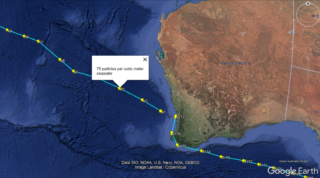Ocean Microplastics
A citizen science collaboration with legendary yachtsman Jon Sanders
In 2018, WA-OIGC teamed up with legendary single-handed yachtsman Jon Sanders in a citizen science project to measure microplastics during his 11th solo circumnavigation of the globe.

Working closely with Jon and his team, WA-OIGC researchers designed a plastic-free water filtration system that could be operated by Jon from the relative safety of inside the bow of his yacht Perie Banou II.
During the voyage, Jon sampled an average 115 L of seawater every day. When in Port, Jon sent the stainless steel filters back to WA-OIGC where they were processed and analysed by Fourier Transform Infrared Spectroscopy (FTIR) by Alan Scarlett.
So far, nearly every filter has contained microplastics. The final set of samples were handed to WA-OIGC director Prof. Kliti Grice when Jon returned to Fremantle on 31st January after his 455-day voyage.
Jon’s voyage was sponsored by the Minderoo Foundation and local businesses. It also received crowd-funding from the general public. WA-OIGC contributed expertise and analyses of the microplastics free of charge.
A profile of Jon Sanders, his 11th circumnavigation and the microplastics project was reported by the Guardian and other media outlets. Jon’s blog from his voyage is available here.
A Google Earth map showing the concentrations of microplastics measured along the global transect route taken by Jon Sanders can be downloaded below. Zoom out to see the route (yellow arrows), then click on any arrow to see the concentration of microplastics recorded at the sampling point.
Download the Google Earth Microplastics Map

Alternatively you can access a google maps version here. Zoom out to see the route (yellow markers), then click on any arrow to see the concentration of microplastics recorded at the sampling point. Note this version does not display data about the ship’s heading.
To read the final report check the link below.
